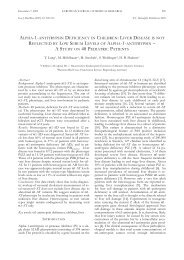European Journal of Medical Research - Deutsche AIDS ...
European Journal of Medical Research - Deutsche AIDS ...
European Journal of Medical Research - Deutsche AIDS ...
You also want an ePaper? Increase the reach of your titles
YUMPU automatically turns print PDFs into web optimized ePapers that Google loves.
June 27, 2007 EUROPEAN JOURNAL OF MEDICAL RESEARCH<br />
75<br />
C-) for CD40 (p=0.0018), and 5.37 ± 0.88% (n=7 GBV-C+)<br />
vs. 1.58 ± 0.511% (n=7 GBV-C-) for CD83 (p=0.0041). The<br />
mean fluorescence intensity (MFI) <strong>of</strong> CD40 and CD86 was<br />
higher in GBV-C coinfected HIV-1 patients after 24hrs. IFNa<br />
production was comparable between the two groups.<br />
Conclusion: HIV-1 patients coinfected with GBV-C have a higher<br />
percentage <strong>of</strong> pDCs expressing CD40 and CD83. This significant<br />
difference suggests that certain phenotypic characteristics <strong>of</strong><br />
pDC are influenced by GBV-C coinfection in HIV-1 infection.<br />
C.13 (Poster)<br />
Hepatitis B virus markers in HIV-infected<br />
pregnant women<br />
Weizsaecker K. 1 , Casteleyn S. 1 , Siedentopf J.-P. 1 ,<br />
Feiterna-Sperling C. 2<br />
1 Charité Universitätsmedizin, Klinik für Geburtsmedizin,<br />
Berlin, Germany, 2 Charité Universitätsmedizin, Klinik für pädiatrische<br />
Pneumologie und Immunologie, Berlin, Germany<br />
Objective: Hepatitis B virus (HBV) coinfection is common in<br />
HIV-infected individuals. According to current German prenatal<br />
care guidelines only HBsAg-status is determined during<br />
the third trimester <strong>of</strong> pregnancy. Newborns <strong>of</strong> HBsAg-positive<br />
mothers receive active and passive immunization immediately<br />
after delivery in order to prevent vertical transmission<br />
<strong>of</strong> HBV. There is little data about the seroprevalence <strong>of</strong> HBVmarkers<br />
in HIV-infected pregnant women.<br />
Methods: HIV-infected women were cared for at our center during<br />
a total <strong>of</strong> 245 consecutive pregnancies from January 1998<br />
to February 2006. HBsAg, anti-HBs, anti-HBc (IgG and IgM)<br />
as well as HCV-antibodies and HCV-PCR were determined.<br />
Results: 38.7% <strong>of</strong> women showed evidence <strong>of</strong> past or present<br />
HBV-infection; HBsAg was positive in 5.3%. The seroprevalence<br />
<strong>of</strong> hepatitis B markers in HBsAg-negative women was as<br />
follows: Both anti-HBs and anti-HBc positive 22.4%, only anti-<br />
HBc positive 12.9%, only anti-HBs positive 9.1%, all markers<br />
were negative in 49.6% <strong>of</strong> women, data were incomplete in<br />
6.0%. Anti-HBc as the only positive marker was found more<br />
frequently among women from high-prevalence regions<br />
(20/119 or 16.8%) and especially among HIV/HCV coinfected<br />
patients (12/45 or 26.7%).<br />
Conclusions: Markers <strong>of</strong> HBV-infection were detected in a<br />
high proportion <strong>of</strong> HIV-infected pregnant women at our center.<br />
Especially anti-HBc-only positive women may be potentially<br />
infectious in spite <strong>of</strong> negative HBsAg-status, and the risk <strong>of</strong><br />
vertical transmission <strong>of</strong> HBV cannot be completely ruled out in<br />
this group. Therefore complete HBV-serology should be part <strong>of</strong><br />
routine prenatal care for all HIV-infected women. Furthermore,<br />
only 15.4% <strong>of</strong> all eligible patients showed serological evidence<br />
<strong>of</strong> HBV-vaccination, a rate that could be greatly improved.<br />
C.14 (Poster)<br />
Relapse <strong>of</strong> HCV viremia in two patients with spontaneous<br />
HCV-clearance after restarting HAART<br />
Sauter F. 1 , Wojcik K. 2 , Kupfer B. 3 , Schwarze-Zander C. 2 ,<br />
Bliesener N. 2 , Rockstroh J.K. 2<br />
1 Universität Bonn, Medizinische Klinik 1, Köln, Germany,<br />
2 Universität Bonn, Medizinische Klinik 1, Bonn, Germany,<br />
3 Universität Bonn, Virologie, Bonn, Germany<br />
Overall, in the natural course <strong>of</strong> HIV/HCV coinfection, higher<br />
HCV-RNA levels are found in HIV seropositive patients as<br />
compared to HIV seronegative patients with hepatitis C. Indeed,<br />
analysis <strong>of</strong> HCV-RNA levels in haemophiliacs showed<br />
that mean HCV-RNA levels increased by 1 log over the first 2<br />
years after HIV-seroconversion. Which impact HAART has<br />
on HCV kinetics so far is still discussed controversially.<br />
Here we describe 2 rare cases <strong>of</strong> patients, in which after<br />
having experienced spontaneous HCV-RNA clearance after<br />
developing severe CD4-depletion, reappearance <strong>of</strong> HCV occurred<br />
when CD4 counts started rising again after initiation or<br />
ongoing HAART. Acute reinfection during the observation<br />
period was ruled out. In one case a new HAART regimen<br />
(TDV,FTC, LPV/r) was started after CD4-counts had fallen<br />
down to 14 cells/l. HIV viral load was then above 500.000<br />
copies/ml. At the same time HCV-RNA became undetectable<br />
after having continuously fallen during the last years. In the<br />
other patient HCV-RNA clearance was documented 6 months<br />
after HAART (LPV/r, ABC,3TC) was initiated but here, due<br />
to compliance problems, HIV-RNA remained detectable. Indeed<br />
HCV clearance was documented at 20.000 HIV-RNA<br />
copies and progredient CD4 count loss with CD4-levels between<br />
14 and 40 cells/l. Subsequently, compliance was improved<br />
and HIV-RNA became undetectable (





